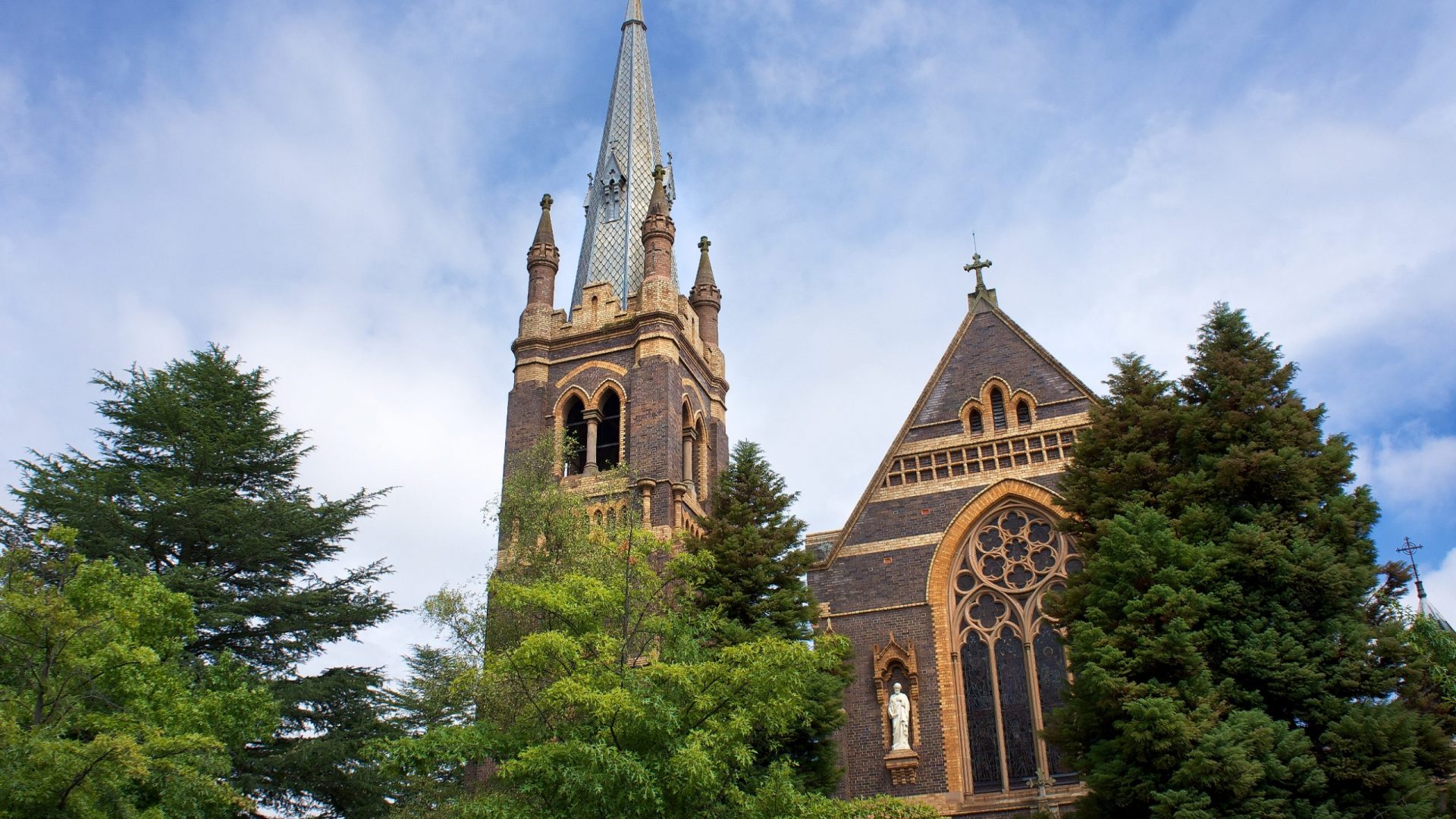

Discover Armidale through Soundtrails audio-locative technology
Experience our region’s history and culture through Soundtrails – self-paced locative audio walks delivered to you through an interactive app platform suitable for most mobile devices.
Soundtrails are self-paced trails with locative audio recordings designed to immerse you in the stories of your surroundings. Using GPS technology, the stories are delivered as you make your way along the trail via an interactive app platform, suitable for most mobile devices. The original compositions, local voices, and world class production truly bring places and their stories to life.
What’s new? If you’re visiting New England High Country, we have four brand new national park Soundtrails. Download the Soundtrails app and come up and explore the Wollomombi Falls Soundtrail near Armidale and the Apsley Falls Soundtrail near Walcha, both in Oxley Wild Rivers National Park, along with the Coombadjha Walk Soundtrail in Washpool National Park east of Glen Innes and the Bald Rock National Park Soundtrail north-east of Tenterfield.
New England High Country group in partnership with Soundtrails and New South Wales National Parks and Wildlife Services have created these experiences to share the local stories and historical, cultural and geographical significance of four of our region’s popular natural attractions. This project is an Australian Bushfire Recovery Initiative to enhance our region’s nature experiences.
Armidale Catholic Precinct
Introducing The Catholic Precinct Soundtrail – a geo locative audio walk and meditation of one of Armidale’s most loved historic sites.
This comes to us through the eyes (and ears) of a group of gifted young Aboriginal kids who herald from across the Armidale Catholic diocese, from as far as Walgett to Tenterfield. These kids (dubbed Wii Gaay kids – Kamilaroi for clever kids) were given free rein of the place and after figuring out how to use the digital recorders and microphones and the right questions to ask, they went forth: interviewing principles and Fathers and local historians, playing the cathedral organ and opening and closing confessional doors.
Starting in Central Park and finishing outside St Mary’s school, this soundtrail takes in 160 years of history, the Bishops, the whispers of confession and the Ursuline convent – formerly an enclosed order.
Just as importantly, it attests to the ongoing relationship between the Armidale Catholic diocese, the local Aboriginal families who lived in East Armidale and the broader Armidale community.
It mixes voices, prayer, song, story, Gregorian chant and even rap into the recognisable signature of the Soundtrails audio walks.
The Catholic Precinct Soundtrail is a feast for the ears. Go forth and discover!
Wollomombi Falls – Oxley Wild Rivers National Park
East of Armidale, Wollomombi Falls is one of the country’s largest waterfalls. You can often see torrents of water cascading from the grassy New England tableland into the vast and wild gorge system beneath it.
The name Wollomombi derives from an Aboriginal word meaning the meeting of two waters, but a lot of local elders simply refer to it as the place of the lyrebird.
Tracing the Wollomombi gorge rim, this trail takes in four breathtaking lookouts and two incredible waterfalls. It offers a rare glimpse into the ecology, colonial history, and the traditional stories embedded in this ancient landscape.
Armidale elder Steve Widders guides walkers along the trail, as we hear the lyrebird Dreaming story, the poetry of Judith Wright, and how this place opens a window into the evolution of life on earth since the time of the Gondwana supercontinent.
Before venturing out check the NPWS website for the latest park information.
This Soundtrail is an Australian Government Bushfire Recovery Initiative, brought to you by New England High Country tourism group in partnership with Soundtrails. Credits and Contributors.
You can discover more Soundtrails throughout New England High Country below
Apsley Falls – Oxley Wild Rivers National Park
Apsley Falls offers some of the most remarkable scenery in Eastern Australia, where untouched wilderness meets undulating farmland. After meandering gently across Walcha’s High Country, the Apsley River rises rapidly here, and then plummets from sheer slate cliffs into depths below. Continuing its journey through the Macleay Gorges Wilderness area, the river eventually reaches the Pacific Ocean at South West Rocks.
This is where the rainbow serpent went underground, where Aboriginal people built fish traps and made kitchens on rockfaces.
When the first Europeans brought thousands of sheep into the area, the gorge became a site of intense conflict. It’s a place of stunning beauty, home to rare and fascinating wildlife. But for some, Apsley Falls is also a place of unsettling melancholy, with a history that is still being reckoned with.
Take a walk along the gorge rim with scientists, artists, elders and rangers, as we journey beyond breathtaking views and into the deeper layers of meaning held in these rocks and waterways.
Before venturing out check the NPWS website for the latest park information.
This Soundtrail is an Australian Government Bushfire Recovery Initiative, brought to you by New England High Country tourism group in partnership with Soundtrails. Credits and Contributors.
Bald Rock National Park
Bald Rock is reputed to be the largest granite monolith and lies just east of the Queensland border. That’s granite, not rock! Once a cattle property, then earmarked for a sanitorium, Bald Rock was first gazetted as a national park in the 1970s and ever since then it has been a major drawcard for visitors to the Tenterfield region.
This Soundtrail takes us into the bedrock, stone and stories of Bald Rock, from Bundjalung ancestral songs and the Clever man to the voice of the first park ranger, to the recent bush fires. Hewn as much through sound, songs and stories as through granite tors, the weathering of time and tectonic plates, the Bald Rock Soundtrail is a must for the discerning visitors who recognise that with such places there is always so much more to discover.
Choose your walk – either along the Bungoona walk or up the steeper rock face – and allow up to three hours return. This is a moderately demanding walk for which you will need water, hat, and reasonable footwear. Enjoy.
Before venturing out check the NPWS website for the latest park information.
This Soundtrail is an Australian Government Bushfire Recovery Initiative, brought to you by New England High Country tourism group in partnership with Soundtrails. Credits and Contributors.
Coombadjha Walk – Washpool National Park
World heritage-listed Washpool National Park is a place of dramatic gorges, crystal-clear waters and magnificent ancient rainforest. It’s situated almost midway between Glen Innes and Grafton on the NSW north coast. For many thousands of years Washpool has been important. It was a meeting place for the Bundjalung, Ngarrabul and Gumbaynggir nations: a place of creation stories, initiation and sacred sites, of abundant food and water and, when Europeans arrived, a place of refuge. In the 1900s it was a place of work for cedar cutters and sawmillers. One of them, Bill Haydon, a man known as ‘the Cedar King’, got lost there and was never found, after one of the largest searches in NSW history. Later still, it was a site for strong protest from conservationists, leading to its eventual listing as World Heritage protected. Washpool’s importance now lies in the study of its natural beauty – its diverse trees, plants, birds and wildlife tell us much about its past and our collective future.
On this walk, we hope to give you a taste of this Washpool National Park’s rich history, through stories of people who’ve wandered this trail.
Before venturing out check the NPWS website for the latest park information.
This Soundtrail is an Australian Government Bushfire Recovery Initiative, brought to you by New England High Country tourism group in partnership with Soundtrails. Credits and Contributors.
Goonoowigall – State Conservation Area
Welcome to the Goonoowigall Soundtrail, a geo locative audio experience coming to you from Jukembal land as part of the Kamilaroi nation.
This is a living audio portrait of the Aboriginal people who lived here, just out of Inverell, from the 1940s to the 70s.
‘Goonoowigall’ means place of wallaby, but back then it was referred to as Sheep Station Gulley or just The Gulley: a gently sloping granite outcrop of rocks and bush, interspersed with tin huts and tracks.
From here people came and went over thirty years. Its proximity to town, a local school, clean water, bush tucker and relative safety from the welfare or police, made it an attractive place to many.
When farms were being mechanised and broken up, and Aboriginal people were leaving their land and chose not to live in government run compounds – sometimes referred to as missions – this was where they came. Some came because they had nowhere else to go, others were broken hearted, many had family, and all were welcome.
This site affords us an intimate living document into what life was like here, and is a powerful testimony to strength and endurance. Enjoy!
Before venturing out check the NPWS website for the latest park information.
Tenterfield
Just 20km south of the border, Tenterfield is a clear-sky town at the very tip of New South Wales. Rimmed by national parks and large granite outcrops, this is a town built on crossroads; between the coast and the western plains, traditional aboriginal tribal lands, states lines, time zones and railway gauges.
The Tenterfield soundtrail is a geo locative audio walk that carries us up the creek and down the main street of town, and into the history, the hearts and minds of the locals.
Hear stories of the ghosts in the jailhouse, the playful patter of what it means to be a local, talking cats, German brass bands and Peter Allen’s manna from heaven.
This is a celebration of Tenterfield – the town, its history and people. Beautiful sounds and stories produced by world-class radio producers … with some help from the kids of St Joseph’s school.
Uralla
The much loved town of Uralla has one of the fastest growing populations of the Northern Tablelands. A popular stopping off point en route between Brisbane and Sydney, Uralla is renowned for its long winters, its heritage buildings and its spectacular granite outcrops.
Uralla’s collective memory is underpinned by a rich vein of stories that are actively treasured; from the new arts scene in the 70s and antics of the Lone Rock Cafe, to the cycle of boom and bust wool prices in the 50s, right back to the first foundry, gold mining culture and connection to bush rangers. (Most everyone here can spin a tale about Captain Thunderbolt!)
The Uralla Soundtrail is a powerful geo locative audio walk that brings alive a heady mix of sounds and stories that span many generations, many people, and many lives. Enjoy!
Walcha Sculptures
Introducing the Walcha Sculpture Soundtrail. A highly original sound walk that takes us into the heart of the towns Open Air Gallery and makes clear why Walcha is increasingly renowned in the arts circuit today.
From Stephen King’s The Weather Signs to Gordon Hookey’s Rainbow Serpent, and ending at the Beacon overlooking town in Anzac Park: this is an intimate portal into the creative heartbeat of this town and her people.
Produced by internationally recognised sound artist, Hamish Sewell, narrated by bestselling local author John Heffernan and with rhythm and tunes of The Grimm Brothers, the Walcha Sculpture Soundtrail is pitch perfect for those who want an adventure and wish to know more about this remarkable little town.
How did the Open Air Gallery come about?
What’s the connection with Sydney’s Sculpture By The Sea and why does the Apsley River crossing still hold sway with the locals today?
The Walcha Sculpture Soundtrail: surprising, performative and informative, but never dull.
